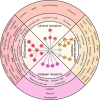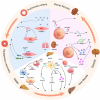Targeting integrin pathways: mechanisms and advances in therapy
- PMID: 36588107
- PMCID: PMC9805914
- DOI: 10.1038/s41392-022-01259-6
Targeting integrin pathways: mechanisms and advances in therapy
Abstract
Integrins are considered the main cell-adhesion transmembrane receptors that play multifaceted roles as extracellular matrix (ECM)-cytoskeletal linkers and transducers in biochemical and mechanical signals between cells and their environment in a wide range of states in health and diseases. Integrin functions are dependable on a delicate balance between active and inactive status via multiple mechanisms, including protein-protein interactions, conformational changes, and trafficking. Due to their exposure on the cell surface and sensitivity to the molecular blockade, integrins have been investigated as pharmacological targets for nearly 40 years, but given the complexity of integrins and sometimes opposite characteristics, targeting integrin therapeutics has been a challenge. To date, only seven drugs targeting integrins have been successfully marketed, including abciximab, eptifibatide, tirofiban, natalizumab, vedolizumab, lifitegrast, and carotegrast. Currently, there are approximately 90 kinds of integrin-based therapeutic drugs or imaging agents in clinical studies, including small molecules, antibodies, synthetic mimic peptides, antibody-drug conjugates (ADCs), chimeric antigen receptor (CAR) T-cell therapy, imaging agents, etc. A serious lesson from past integrin drug discovery and research efforts is that successes rely on both a deep understanding of integrin-regulatory mechanisms and unmet clinical needs. Herein, we provide a systematic and complete review of all integrin family members and integrin-mediated downstream signal transduction to highlight ongoing efforts to develop new therapies/diagnoses from bench to clinic. In addition, we further discuss the trend of drug development, how to improve the success rate of clinical trials targeting integrin therapies, and the key points for clinical research, basic research, and translational research.
© 2022. The Author(s).
Conflict of interest statement
The authors declare no competing interests.
Figures







References
-
- Kechagia JZ, Ivaska J, Roca-Cusachs P. Integrins as biomechanical sensors of the microenvironment. Nat. Rev. Mol. Cell Biol. 2019;20:457–473. - PubMed
-
- Zheng Y, Leftheris K. Insights into protein-ligand interactions in integrin complexes: advances in structure determinations. J. Med. Chem. 2020;63:5675–5696. - PubMed
Publication types
MeSH terms
Substances
LinkOut - more resources
Full Text Sources
Other Literature Sources
Miscellaneous

